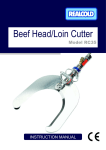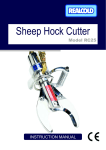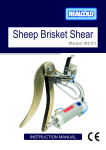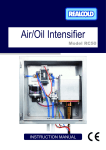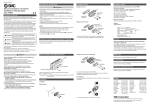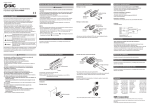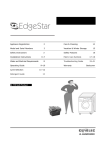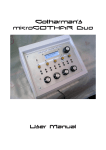Download RC45 Service Manual - argus realcold pty limited
Transcript
Beef Horn Cutter Model RC45 INSTRUCTION MANUAL Imported by: Licensed distributor Designation: Model No: Specifications: Beef Horn Cutter RC45 Type: Length: Height: Width: Blade Opening: Blade Reach: Weight: 1215 765mm 236mm 250mm 130mm 168mm 29.15Kg Supplied Type: Length: Height: Width: Blade Opening: Blade Reach: Weight: 1217 765mm 236mm 250mm 130mm 168mm 30.0Kg Supplied Hydraulic Circuit: 201Bar/3000Psi BP HLPM46 or equivalent 6.5-7.85Bar/90-110Psi Pneumatic Circuit: Serial No: Test Date: Manufacture Date: Manufactured By: Argus Realcold Ltd PO Box 12-519 9 Prescott Street, Penrose Auckland, New Zealand Ph ++64 9 526 5757 Fax ++64 9 526 5755 TABLE OF CONTENTS SAFETY INSTRUCTIONS 1 NOTICE TO OPERATORS 2 INSTRUCTIONS FOR COMMISSIONING 3 SERVICE SECTION 4 PRINCIPLE OF OPERATION: Cutting Cycle: Opening Cycle: SERVICING: Handtool Disassembly: Servicing: Reassembly: 4 4 4 5 5 7 9 APPENDIX 1 13 Parts List RC45-1215 Parts Diagram RC45-1215 Parts List RC45-1217 Parts Diagram RC45-1217 Order Form 14 15 16 17 18 APPENDIX 2 19 Maintenance: Check Daily: Check Weekly: Routine Maintenance: 20 20 21 22 APPENDIX 3 23 Blade Sharpening 24 APPENDIX 4 25 Recommended Spare Parts 26 APPENDIX 5 27 Circuit Schematic 28 Argus Realcold Ltd, PO Box 12-519, 9 Prescott Street, Penrose, Auckland, New Zealand Phone +64-9-526 5757, Fax +64-9-526 5755, Email : [email protected] , www.argus.co.nz Issue Date: 18-2-2005 Revision Number: 2.1 Revision Date: 19-6-2006 SAFETY INSTRUCTIONS FOR REALCOLD HAND TOOLS As a designer, manufacturer, and supplier of plant and equipment Argus Realcold Ltd has provided plant, equipment, and all relevant information to ensure the safe use in accordance with the New Zealand Health and Safety in employment Act 1992. The “CE” marked machines provided by Argus Realcold Ltd also meet the EC machinery directive 98/37/EC and any other relevant EC directive. It is the responsibility of the owner to ensure that the machine is used safely in accordance with the instructions and for the purpose that the machine was designed for. The hand tools that we supply, with the exception of the RC33, are designed for two-handed operation and include the following: RC20 Sheep Light Duty Scissor RC21 Sheep Hock Cutter (Various blade options available) RC22 Hydraulic Sheep Hock/Horn/Neck Cutter RC25 Hydraulic Heavy Duty Sheep/Goat/Deer Hock/Horn Cutter RC30 Hydraulic Beef Hock/Horn Cutter, Hog Head Cutter (Various blade options available) RC31 Pneumatic Sheep & Lamb Brisket Opener RC33 Pneumatic Wool Shear RC35 Hydraulic Beef Loin/Head Cutter (Various blade options) RC45 Hydraulic Heavy Duty Beef Horn Cutter RC50 Air/Oil Intensifier Argus Realcold Ltd, PO Box 12-519, 9 Prescott Street, Penrose, Auckland, New Zealand Phone +64-9-526 5757, Fax +64-9-526 5755, Email : [email protected] , www.argus.co.nz 1 NOTICE TO OPERATORS, MAINTENANCE, AND CLEAN-UP PERSONNEL OPERATORS Stop using a defective or malfunctioning tool immediately. Report the problem or defect immediately to your supervisor for removal of tool from service. Do not attempt to make repairs yourself; do not tamper with a defective or malfunctioning tool. Do not attempt to free a jammed or blocked tool yourself. Remove power from the tool when the tool is left unattended or is not in use. Never tie-down, bypass, or alter the triggers or safety switches of the tool. Wear safety glasses when operating this tool. Do not activate switches of the tool unless you intend to operate and use the tool. Do not allow unauthorised individuals to operate the tool. Never place fingers, hands, or other parts of your body in the cutting path of the tool. This tool is capable of causing severe injury or death if misused. CLEAN-UP PERSONNEL Shut off all power and disconnect all hydraulic and air hoses from the tool before performing clean up. Take extreme care near sharp blades. MAINTENANCE PERSONNEL Shut off all power and disconnect all hydraulic and air hoses from the tool before making repairs, performing maintenance, and before replacing or sharpening blades. Do not use substitute parts or use other than genuine Argus Realcold brand parts. Use extreme care when testing or operating the tool. Argus Realcold Ltd, PO Box 12-519, 9 Prescott Street, Penrose, Auckland, New Zealand Phone +64-9-526 5757, Fax +64-9-526 5755, Email : [email protected] , www.argus.co.nz 2 RC45 BEEF HORN CUTTER INSTRUCTIONS FOR COMMISSIONING 1. Mount a suitable spring balancer unit with a weight range from 22Kg to 30Kg near the operating station, in an appropriate position to ensure ease of operation for the suspended tool. 2. Attach the balancer cable to the hanger ring on the cylinder mount of the hand tool. 3. Connect the hydraulic hoses to the couplers supplied at the rear of the hand tool. 4. Connect the air hoses to the airlines on the hand tool, making sure that air pressure is supplied to the RED hoses, and the GREEN hoses are connected to the signal line. 5. Connect the power pack and operate the tool a few times to purge any air from the hand tool and hydraulic hoses. 6. Tie the hydraulic hoses and air lines together and arrange them so that they are out of the way of the operator. Note: The use of cable ties for this can cause the air lines to pinch preventing the hand tool from operating correctly. We recommend using electrical tape instead. Your RC45 Hand tool is now ready for service. Argus Realcold Ltd, PO Box 12-519, 9 Prescott Street, Penrose, Auckland, New Zealand Phone +64-9-526 5757, Fax +64-9-526 5755, Email : [email protected] , www.argus.co.nz 3 SERVICE SECTION Before servicing this tool it is important to understand how this tool operates. While being very simple, understanding the principles of operation and their interaction will assist you to maintain the tool to optimum working efficiency. Fault diagnosis and repair will also be greatly simplified. PRINCIPLE OF OPERATION: Cutting Cycle: Operating valves are depressed supplying a positive air pressure signal to the pilot of the power pack control board. • The pilot pressure shuttles the control valve allowing main supply air pressure to operate the power pack hydraulic valve. • The hydraulic valve opens and hydraulic pressure is transmitted to the rear port of the hand tool via the hydraulic hose. • This hydraulic pressure then acts on the piston rod assembly in the hand tool, and causes the piston rod assembly to move. • The movement of the piston rod assembly is now transmitted to the moveable blade and the blades close. • Hydraulic pressure will build to 201 bar/3000 PSI as soon as cutting pressure is exerted, causing the blades to cut through the animal’s appendage. Opening Cycle: • Operating valves are released allowing the positive air pressure signal to vent through the valve exhaust port. • The pilot pressure shuttles the control valve allowing main supply air pressure to operate the power pack hydraulic valve closing side. • The hydraulic valve opens and hydraulic pressure is transmitted to the front port of the hand tool via the hydraulic hose. • This hydraulic pressure then acts on the piston rod assembly in the hand tool, and causes the piston rod assembly to be retracted. • The movement of the piston rod assembly now pulls the moveable blade to the open position. • A timer removes the air pressure signal from the hydraulic valve once the piston is fully retracted allowing the hydraulic valve to return to centre and remove hydraulic pressure from the hydraulic hoses. The operating cycle is now complete. 4 SERVICING: Before any servicing is attempted on this tool disconnect and unplug the power pack from electrical supply. Disconnect any air supply to the power pack. All hydraulic hoses and air supply hoses must be disconnected to render the tool inoperative according to Occupational Safety & Health requirements. Handtool Disassembly: Before starting please make sure that the tool is clean and that you have a suitable work area available. A container will help prevent small parts from being lost or damaged. 1. Place the tool onto the bench. 2. Loosen the grub screws and push the two-way valves out of the handles. Carefully remove the airlines from the hose barb fittings. Put these items into the parts container. Note: Be careful, these fittings are easily broken. 3. Remove the two button screws securing the tube guard to the blade guide and put them into the parts container. Place the hose guard with the hose still in it aside. 4. Remove the bolts and handles from the blade guide assembly and put them into the parts container. 5. Using an 8mm Allen key, loosen and remove the cap screw from the yoke. Put it into the parts container. Take care; the moveable blade may slide suddenly in the blade guides. Remember that the blades are sharp! 6. Take a 5mm roll pin punch and carefully drive the two roll pins from their holes. 7. Take two 1 ½ inch ring spanners and place them over diagonally opposite guide nuts. Loosen and remove all the two guide nuts furthest from the hydraulic cylinder and put them into the parts container. 8. Remove the end frame from the blade guides and put it aside on the bench. 9. Loosen and remove the remaining two guide nuts and put them into the parts container. 10. Carefully slide the two blade guides with the blades in place from the cylinder head mount. Lay them on the bench and remove them from the blades. 11. Unscrew the hydraulic couplers and put them into the parts container. 12. Loosen and remove the two hydraulic elbows from the hydraulic cylinder and put them into the parts container. 13. Using a C-spanner, loosen the locking ring at the front of the hydraulic cylinder. 5 14. Unscrew the hydraulic cylinder counter clockwise from the cylinder head mount. 15. Drain any remaining oil from the cylinder into a suitable container. Put the cylinder and clevis assembly onto the bench. 16. Insert a #2 Phillips screwdriver through the hole at the front of the piston rod, and a #3 Phillips screwdriver through the hole in the yoke. Loosen and remove the yoke. 17. Screw the hydraulic cylinder head into the special tool. Mount the special tool into the vice, using the flat sides to grip it. 18. Mount the special wrench over the hydraulic cylinder body. Install the supplied bolt through the hole in the wrench to secure. Unscrew the hydraulic cylinder body counter clockwise. 19. Withdraw the hydraulic piston and rod assembly from the hydraulic cylinder body and put them both on the bench. Take care to retain the hydraulic cylinder spacer. Put it into the parts container. Your RC45 hand tool is now disassembled ready for inspection and servicing. 6 Servicing: 1. Clean all parts thoroughly. 2. Visually inspect all parts for any signs of wear or damage. 3. Blades: Look particularly for nicks in cutting edge. These will quickly develop into cracks if left unattended, leading to dangerous failure of the blade. Look also for wear at the sides where they run in the blade guides. The blades should be a snug fit into the grooves of the guides. The blades may be touched up according to the maintenance instructions in appendix 4. If regrinding it is critical that the blade angles are maintained. This will ensure that your blades maintain peak cutting efficiency. Argus Realcold offers a blade sharpening service. You will find this service to be very cost effective in maintaining your hand tool at peak cutting efficiency. 4. Blade Guides: Inspect for damage or wear. Check also for straightness. If the blade guides are noticeably worn or at all bent then they should be replaced. 5. Seals may be easily removed by hooking them from their locating grooves. Take care not to damage the bronze piston and cylinder head bush. The seals should be replaced each time the tool is serviced. Use only genuine Argus Realcold seals for replacement. These are available in a convenient seal kit: Part number: 110-452105-A 6. Cylinder Body: Inspect for damage. Small nicks or scratches can be polished out with fine (240 grit or finer) wet and dry sandpaper. More severe damage will require replacement. Be aware that even insignificant appearing damage will cut and damage the piston seals , causing premature seal failure. External damage may also be far from cosmetic. It can cause distortion of the cylinder bore, which will damage seals and/or cause them to leak. It may also damage the bronze piston. 7. Piston Rod Assembly: Inspect for damage. Small nicks and scratches may be polished out with fine (240 grit or finer) wet and dry sandpaper. More severe damage will require replacement. Be sure to keep the piston rod clean during service. Be aware that even insignificant appearing damage will cut and damage the cylinder head seals, causing premature seal failure. 8. Yoke and Yoke Bolt: Inspect for damage or wear. If the holes are elongated then replace the yoke. The yoke bolt should be replaced each time the tool is serviced. If the holes are loose then replace the yoke. 7 9. Two Way Valve: Unscrew cover. Withdraw valve spool and spring. Remove O-rings from valve spool. Clean all parts thoroughly. Install new O-rings onto the valve spool. Install spring into valve body. Apply a little air tool oil to the O-rings on the valve spool and insert it through the spring and into the valve body. Reinstall the cover nut over the valve spool and tighten it onto the valve body. 8 Reassembly: Before starting, make sure that all parts are clean and free of oil and grease. Make sure that the mounting faces of the handles are clean and free from oxides. All replacement parts and/or serviced parts should be procured/completed and ready to ha nd. 1. Install New Piston Seals. A piece of plastic strapping can assist to pull the seals into place over the piston. Make sure that the seals are located properly in their grooves and are not twisted. Apply a suitable lubricant to the seals. 2. Install New Cylinder Head Seals. Use a blunt instrument (not a screwdriver) to push the seals fully into their grooves. Make sure that the seals are located properly in their grooves. They should float a little. Apply a suitable lubricant to the seals. 3. Take the piston and rod assembly with its new seal in place and push it into the cylinder body with a twisting motion. It will be a tight fit and difficult to push in by hand. 4. Install the hydraulic cylinder spacer over the piston rod. Let it slide down the rod until it is against the hydraulic piston. Note: Make sure that the spacer is in place before going any further. 5. Install the hydraulic cylinder head into the special tool, and mount the tool into the vice again as you did during disassembly. Carefully install the piston rod through the cylinder head and seals. Screw the cylinder body onto the cylinder head and tighten. Clean any excess grease from the front of the piston rod. 6. Apply a small amount of blue Loctite 243 to the male threads of the piston rod. Turn the hydraulic cylinder over, install the yoke onto the hydraulic piston rod and tighten. 7. Apply food grade grease to the exposed threads of the hydraulic cylinder head and screw the locking ring into place. Put the hydraulic cylinder assembly aside on the bench. 8. Take the blade guides and coat the guide slots with food grade grease. Apply a thin coating of grease to the shoulders at each end of the guide as well. 9. Take the blades and coat the guide edges with food grade grease. 10. Take the blade guide with the two M6 tapped holes and place it on the bench in front of you. Make sure that the guide slot is facing towards you and that the two tapped holes are at the top. 9 11. Carefully insert the fixed blade into the guide slot towards the left hand end of the blade guide. Make sure that the cutting edge is downward and facing toward the right hand end of the guide. 12. Take the moveable blade and carefully insert it into guide slot towards the right hand end of the blade guide. Make sure that the cutting edge is downward and facing towa rd the cutting edge of the fixed blade. Note: Take particular care with this step as it is very easy to install the blades incorrectly. Check the cover photo and the parts diagram for correct alignment. 13. Take the remaining blade guide. Carefully lift the blades from the bench and slide the blade guide into position over the guide edges of the blades. 14. Take the cylinder head mount and place it to the right of the blades and blade guides. Orient it so that the two M8 handle mount holes are facing upward and the hanger eye is at the far side. 15. Lift the blades mounted in the blade guides and carefully slide the ends of the blade guides into the mount holes of the cylinder head mount. Push them all the way in and install two of the guide nuts without tightening them yet. 16. Place the end frame to the left of the blade guide assembly. Orient it so that the two M8 handle mount holes are facing upward and the blade groove is facing toward the blades. 17. Carefully lift the end of the blade guide assembly and slide the end frame into position over the ends of the blade guides. Push it all the way on and install the remaining two guide nuts without tightening them yet. 18. Use the moveable blade to push the fixed blade all the way back into the slot in the end frame. Take the two M5 roll pins and carefully drive them through the end frame and fixed blade to secure. Make sure that the ends of the roll pins are just below the surface of the end frame top face. 19. Take the two 1 ½ inch ring spanners used during disassembly. Remove two diagonally opposite guide nuts and place a small amount of blue Loctite 243 onto the threads of the blade guides. Reinstall the guide nuts and use the two spanners to tighten them fully now. Repeat for the remaining two guide nuts. Note: Check that the moveable blade slides freely in the blade guides before going any further. 20. Take the hydraulic cylinder and screw it into the cylinder head mount. Screw it in to about one third of the depth of the male thread. 10 21. Rotate the cylinder until the hole in the top of the yoke is facing upward. Slide the moveable blade back into the yoke and secure it with the yoke bolt. Apply a little blue Loctite 243 to the thread of the yoke bolt and tighten. 22. To achieve correct blade adjustment this step must be followed strictly. Pull the piston rod out to the end of its stroke. Check that the blades are not touching. Gradually screw the hydraulic cylinder further into the cylinder head mount until the blades contact. Rotate the cylinder a little more until the hydraulic ports are about 1/8 of a turn past vertical. Use a C-spanner to tighten the locking ring into place. Warning: Do not screw the cylinder further into the cylinder head mount than is necessary to achieve blade contact. 23. Take the right handle and place it onto the cylinder head mount. It is the shorter of the two handles. Take two of the M8 button screws and apply a little blue Loctite 243 to the threads. Install the bolts through the holes and tighten. 24. Take the left handle and place it onto the end frame. It is the taller of the two handles. Take the two remaining M8 button screws and apply a little blue Loctite 243 to the threads. Install the bolts through the holes and tighten. 25. Take the tube guard with the paired air hose still in it and mount it onto the blade guide using the two M6 button screws. Apply a little blue Loctite 243 to the threads of the screws. 26. Insert the paired air hose into the hole from the bottom of the left handle. Push the red hose onto hose barb marked “IN”. Push the green hose onto the remaining unmarked hose barb. Coat the brass valve body with food grade grease and push it into the socket at the top of the handle. Push it in until the retaining nut seats against the aluminium handle. Secure it with a 6mm grub screw. 27. Insert the paired air hose into the hole from the bottom of the right handle. Push the red hose onto hose barb marked “IN”. Push the green hose onto the remaining unmarked hose barb. Coat the brass valve body with food grade grease and push it into the socket at the top of the handle. Push it in until the retaining nut seats against the aluminium handle. Secure it with a 6mm grub screw. 28. Arrange the paired air hose so that it passes across the top of the hanger eye. If the protective heat shrink is damaged then replace it. Use a cable tie to temporarily secure the hoses together while installing the new heat shrink tube. 11 29. Apply a small amount of Loctite 569 hydraulic sealer to one of the hydraulic elbows. Screw it into the rear port on the hydraulic cylinder. Tighten it until elbow is pointing rearward, parallel with the centreline of the hand tool. Apply a small amount of Loctite 569 hydraulic sealer to the remaining thread of the hydraulic elbow. Take one of the male hydraulic couplers Screw it onto the hydraulic elbow and tighten. 30. Apply a small amount of Loctite 569 hydraulic sealer to the remaining hydraulic elbow. Screw it into the front port of the hydraulic cylinder. Tighten it until elbow is pointing to the right side of the tool and rearward. Make sure to leave the elbow angled enough for the hydraulic hose to clear the rearmost fitting. Apply a small amount of Loctite 569 hydraulic sealer to the remaining thread of the hydraulic elbow. Screw the female hydraulic coupler back onto the hydraulic elbow and tighten. Check the parts container and bench for any missing parts now. Your RC45 hand tool is now ready to be returned to service. Reinstall as per installation instructions at the front of the manual and test for correct operation. 12 Appendix 1 Appendix 1 Parts Diagram and Ordering Form Argus Realcold Ltd, PO Box 12-519, 9 Prescott Street, Penrose, Auckland, New Zealand Phone +64-9-526 5757, Fax +64-9-526 5755, Email : [email protected] , www.argus.co.nz 13 RC45-1215 BEEF H/D HORN CUTTER ANTI-TIEDOWN ITEM NO. 1 1.1 1.2 1.3 1.4 1.5 1.6 2 3 4 5 6 7 8 9 10 11 12 13 14 15 16 17 18 19 20 21 22 23 24 25 QTY. 1 1 1 1 1 1 1 1 1 1 1 1 1 4 1 1 2 1 2 4 2 2 2 1 4 2 1 1 2 1 2 PART N0. 110-452101-A 110-452102-A 110-452103-A 110-452104-A 110-452105-A 110-452109-A 110-452110-A 130-454101-A 140-455110-A 140-455108-A 140-455109-A 150-456108-A 150-456109-A 160-457109-A 170-458103-B 170-458104-A 170-458105-A 170-458106-A 180-AA90-0606 180-KQ2H04-00 180-QVV-M06 180-QVV-F06 190-209508-B 800-2-MP-4 800-BHM820-304 800-BHM612-304 800-CSM1035-304 800-DE10MM-304 800-GSM66-304 800-HSC9.5 800-RP5X40-304 DESCRIPTION Hydraulic Cylinder Complete Hydraulic Cylinder Body Hydraulic Cylinder Head Piston & Rod Assy Seal Kit Locking Ring Hyd. Cylinder Spacer Yoke Blade Guide Shear Blade, Fixed Shear Blade, Moveable Handle Left Handle Right Guide Nut Cylinder Head Mount End Frame P-Clip Tube Guard Hydraulic Elbow Male Straight Connector 4mm Hydraulic Coupler Male Hydraulic Coupler Female Pilot Valve Red/Green Paired Hose M8x20 Button Head Screw 304 M6x12 Button Head Screw 304 Cap Screw M10x35 304 DIN Eye M10 M6x6 Grub Screw Heat Shrink Clear Roll Pin M5x40 304 8 10 6 17 23 19 20 11 12 18 25 22 4 RC45-1215 BEEF H/D HORN CUTTER ANTI-TIEDOWN 23 17 19 3 7 5 2 14 21 9 8 1.4 1.5 1.2 1.4 1.6 16 1.3 15 1.4 1.1 13 RC45-1217 Beef H/D Horn Cutter Anti-Tiedown, Scalloped Blades ITEM NO. 1 1.1 1.2 1.3 1.4 1.5 1.6 2 3 4 5 6 7 8 9 10 11 12 13 14 15 16 17 18 19 20 21 22 23 24 25 QTY. 1 1 1 1 1 1 1 1 1 1 1 1 1 4 1 1 2 1 2 4 2 2 2 1 4 2 1 1 2 1 2 PART N0. 110-452101-A 110-452102-A 110-452103-A 110-452104-A 110-452105-A 110-452109-A 110-452110-A 130-454101-A 140-455110-A 140-455111-A 140-455112-A 150-456108-A 150-456109-A 160-457109-A 170-458103-B 170-458104-A 170-458105-A 170-458106-A 180-AA90-0606 180-KQ2H04-00 180-QVV-M06 180-QVV-F06 190-209508-B 800-2-MP-4 800-BHM820-304 800-BHM612-304 800-CSM1035-304 800-DE10MM-304 800-GSM66-304 800-HSC9.5 800-RP5X40-304 DESCRIPTION Hydraulic Cylinder Complete Hydraulic Cylinder Body Hydraulic Cylinder Head Piston & Rod Assy Seal Kit Locking Ring Hyd. Cylinder Spacer Yoke Blade Guide Scallop Blade, Moveable Scallop Blade, Fixed Handle Left Handle Right Guide Nut Cylinder Head Mount End Frame P-Clip Tube Guard Hydraulic Elbow Male Straight Connector 4mm Hydraulic Coupler Male Hydraulic Coupler Female Pilot Valve Red/Green Paired Hose M8x20 Button Head Screw 304 M6x12 Button Head Screw 304 Cap Screw M10x35 304 DIN Eye M10 M6x6 Grub Screw Heat Shrink Clear Roll Pin M5x40 304 8 10 6 17 23 19 20 11 12 18 25 22 RC45-1217 Beef H/D Horn Cutter Anti-Tiedown, Scalloped Blades 23 5 17 19 3 7 4 2 14 21 9 8 1.4 1.5 1.2 1.4 1.6 16 1.3 15 1.4 1.1 13 ? 9 Prescott Street PO Box 12-519 Penrose, Auckland New Zealand Ph 09 526 5757 Fax 09 526 5755 [email protected] Order Number Date Tool Serial Number Customer Order Form Name Address Phone Contact Person Qty Part Number Description Shipping Instructions: Ship to Address Attention Level of Urgency Normal Urgent 18 Appendix 2 Appendix 2 Maintenance Argus Realcold Ltd, PO Box 12-519, 9 Prescott Street, Penrose, Auckland, New Zealand Phone +64-9-526 5757, Fax +64-9-526 5755, Email : [email protected] , www.argus.co.nz 19 Maintenance: Please read this section thoroughly and make sure that these maintenance checks are carried out routinely as specified. Adherence to this maintenance schedule will ensure that you enjoy long and trouble free service from your hand tool. Before any servicing is attempted on this tool, disconnect and unplug from air supply. All hydraulic hoses and air supply hoses must be disconnected to render the tool inoperative according to Occupational Safety & Health requirement. Check Daily: 1. Clean the hand tool thoroughly before inspecting. 2. Visually inspect the hand tool for any obvious damage to components, and for loose components. Anything that you find at this stage must be remedied immediately. The hand tool may need to be removed from service to affect remedy. 3. Look for oil leaking past the front of the cylinder head seal. If there is oil present then the cylinder head seal is bypassing and must be replaced. 4. Apply food grade grease to the blade guides. 5. Wipe off excess grease before returning the hand tool to service. 6. Check the oil level in the hydraulic power pack (where applicable). It should be between ½ and ¾ of the way up the sight glass mounted on the tank. Refill as necessary. Check the oil for colour and cleanliness at the same time. If the oil has a milky appearance then it is water contaminated and must be changed immediately. Refer to your power pack manual for instructions. 7. Reconnect the hand tool and check that all couplers and fittings are tight. 8. Reconnect the air supply and test for correct operation. These checks are to be performed on a daily basis, or prior to the start of each shift where more than one shift operates each day. 20 Check Weekly: This maintenance is best performed in the workshop. 1. Remove the blades from the hand tool as per the instructions for disassembly. 2. Thoroughly clean the blade guides, and blades. The grease used for lubrication becomes dry and hard, building up a layer of dried grease after repeated exposure to heat from the sterilising process. 3. Visually inspect the hand tool for any obvious damage to components, and for loose components. Check all fasteners for tightness. Anything that you find at this stage must be remedied immediately. 4. Check the yoke bolt, yoke, blades, and blade guides for wear as per the instructions for servicing. If they are loose or obviously worn then replace them now. 5. Check the blades for sharpness or edge damage. Should they be dull or damaged then sharpen them as per the sharpening instructions in appendix 3. Sharpen both blades evenly. 6. Apply grease to the blade guides and reassemble them to the tool as per the instructions for reassembly. 7. Reassemble the blades to the tool as per the instructions for reassembly. 8. Wipe off excess grease before returning the hand tool to service. 9. Reconnect the hand tool and check that all couplers and fittings are tight. 10. Reconnect the air supply and test for correct operation. These checks are to be performed on a weekly basis, or approximately every 40 hours of service where more than one shift operates each day. 21 Routine Maintenance: Except where daily or weekly checks require replacement of wear items, the hand tool should be fully stripped and serviced once every six months. Wear items that should be replaced at this six month service are: • • 110-302105-A 800-CSM1035-304 Seal kit M10 x 35 Cap screw 304 All other components should be assessed for serviceability at this time and replaced as necessary, as per the servicing instructions in the service section of this manual. Other factors which may necessitate a full service prior to this six month interval include but are not limited to: • • • • Power pack oil found to be dirty Power pack oil found to be water contaminated Blades damaged (i.e., accidental cutting onto the gambol) Other damage caused by dropping or striking of the tool Following the discovery of any of these occurrences the hand tool must be removed from service, stripped, and thoroughly assessed for damage. 22 Appendix 3 Appendix 3 Blade Sharpening Argus Realcold Ltd, PO Box 12-519, 9 Prescott Street, Penrose, Auckland, New Zealand Phone +64-9-526 5757, Fax +64-9-526 5755, Email : [email protected] , www.argus.co.nz 23 Blade Sharpening In order to sharpen these blades it is necessary for you to have access to surface grinding equipment and be competent in its use. Do not attempt to sharpen these blades otherwise. Mount the blade vertically on the surface grinder. Grind the face of the blade until a clean straight edge is achieved. Mount the blade at 45° on the surface grinder. Carefully grind between the roots of the two end radii until a sharp cutting edge is achieved. Use a stone to remove the burr created by surface grinding. As the witness on the cutting edge becomes wider it will be necessary to use an end mill to machine the primary angle back to specification. Take care to maintain the blade primary angle at 30°. The witness should not be wider than 5mm from the front face of the blade. It is recommended that the polished finish be restored to retain the hygiene qualities of the blade. Under no circumstance should an angle grinder or disc sander be used. Failure to follow these sharpening instructions will void the manufacturer’s warranty. Argus Realcold Ltd offer a blade reconditioning service that will restore your blades to the original condition, which you will find to be very cost effective in maintaining your blades at peak efficiency. Argus Realcold Ltd, PO Box 12-519, 9 Prescott Street, Penrose, Auckland, New Zealand Phone +64-9-526 5757, Fax +64-9-526 5755, Email : [email protected] , www.argus.co.nz 24 Appendix 4 Appendix 4 Recommended Spare Parts Argus Realcold Ltd, PO Box 12-519, 9 Prescott Street, Penrose, Auckland, New Zealand Phone +64-9-526 5757, Fax +64-9-526 5755, Email : [email protected] , www.argus.co.nz 25 Recommended Spare Parts The following is a list of spare parts that we recommend your engineering department to keep in stock at all times. Having these parts on hand will assist you to maintain your tool in good working order, and ensure that you avoid down time while waiting for parts delivery should your hand tool require repair. This list is a minimum recommendation for parts to support one unit in the field. Where more than one tool is in service, quantities held in stock should be adjusted accordingly. Qty Part Number Description 2 110-452105-A HYDRAULIC CYLINDER SEAL KIT 1 130-454101-A YOKE 1 140-455108-A SHEAR BLADE FIXED 1 140-455109-A SHEAR BLADE MOVEABLE 10 180-3X1.5-N70 VALVE O RING 4 180-KQ2H04-00 PNEUMATIC STRAIGHT 2 180-QVV-F06 COUPLING SCREW TYPE FEMALE 2 180-QVV-M06 COUPLING SCREW TYPE MALE 2 190-209508-B PILOT VALVE 4 190-209602-A PILOT VALVE COVER NUT 4 190-209603-A VALVE SPRING 4 800-CSM1035-304 M10 X 35 CAP SCREW 304 800-2-MP-4 HOSE 5m Argus Realcold Ltd, PO Box 12-519, 9 Prescott Street, Penrose, Auckland, New Zealand Phone +64-9-526 5757, Fax +64-9-526 5755, Email : [email protected] , www.argus.co.nz 26 Appendix 5 Appendix 5 Circuit Schematic Argus Realcold Ltd, PO Box 12-519, 9 Prescott Street, Penrose, Auckland, New Zealand Phone +64-9-526 5757, Fax +64-9-526 5755, Email : [email protected] , www.argus.co.nz 27 ITEM 1 2 3 4 5 6 7 8 9 10 11 12 13 14 15 15 1 6mm A B 5 T 4 8 6 COPYRIGHT: THIS DOCUMENT IS THE PROPERTY OF ARGUS REALCOLD LTD IT MUST NOT BE COPIED OR THE CONTENTS PASSED ON TO ANY THIRD PARTY WITHOUT THE WRITTEN CONSENT OF THE COMPANY HYDRAULIC HOSE 12.7mm ID 21.0Mpa/3000Psi RATED A B 2 EB P EA DESCRIPTION OPERATING SWITCHES, 3/2 N/NP SPRING RETURN LOGIC VALVE, "AND" FUNCTION 0.3sec OPERATING VALVE 5/2 SPRING RETURN PNEUMATIC TIMER HYDRAULIC VALVE 5/2 OPEN CENTRE PRESSURE RELIEF VALVE RETURN FILTER TEST POINT FILLER/STRAINER/BREATHER ELECTRIC MOTOR DRIVE COUPLING HYDRAULIC PUMP SIGHT LEVEL/TEMP GUAGE OVER TEMP SWITCH HAND TOOL CYLINDER D/A HYDRAULIC PNEUMATIC SUPPLY 6.7Bar/100Psi 3 Q.A MFG APPV'D CHK'D DRAWN B EAST M ROBINS NAME UNLESS OTHERWISE SPECIFIED: DIMENSIONS ARE IN MILLIMETERS SURFACE FINISH: TOLERANCES: LINEAR: ANGULAR: SIGNATURE FINISH: 7 9 DATE MATERIAL: 16-2-2005 16-2-2005 PART NO OLD DEBUR AND BREAK SHARP EDGES 12 11 REVISION A 14 13 SCALE:1:1 SHEET 1 OF 1 RC22-CIRC A3 CIRCUIT DIAGRAM RC22, RC30, RC35, RC45 PART NO. TITLE: DO NOT SCALE DRAWING M 10































